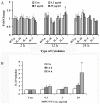Proteomic analysis of cellular response induced by multi-walled carbon nanotubes exposure in A549 cells
- PMID: 24454774
- PMCID: PMC3891800
- DOI: 10.1371/journal.pone.0084974
Proteomic analysis of cellular response induced by multi-walled carbon nanotubes exposure in A549 cells
Abstract
The wide application of multi-walled carbon nanotubes (MWCNT) has raised serious concerns about their safety on human health and the environment. However, the potential harmful effects of MWCNT remain unclear and contradictory. To clarify the potentially toxic effects of MWCNT and to elucidate the associated underlying mechanisms, the effects of MWCNT on human lung adenocarcinoma A549 cells were examined at both the cellular and the protein level. Cytotoxicity and genotoxicity were examined, followed by a proteomic analysis (2-DE coupled with LC-MS/MS) of the cellular response to MWCNT. Our results demonstrate that MWCNT induces cytotoxicity in A549 cells only at relatively high concentrations and longer exposure time. Within a relatively low dosage range (30 µg/ml) and short time period (24 h), MWCNT treatment does not induce significant cytotoxicity, cell cycle changes, apoptosis, or DNA damage. However, at these low doses and times, MWCNT treatment causes significant changes in protein expression. A total of 106 proteins show altered expression at various time points and dosages, and of these, 52 proteins were further identified by MS. Identified proteins are involved in several cellular processes including proliferation, stress, and cellular skeleton organization. In particular, MWCNT treatment causes increases in actin expression. This increase has the potential to contribute to increased migration capacity and may be mediated by reactive oxygen species (ROS).
Conflict of interest statement
Figures










Similar articles
-
Effects of nitrogen-doped multi-walled carbon nanotubes compared to pristine multi-walled carbon nanotubes on human small airway epithelial cells.Toxicology. 2015 Jul 3;333:25-36. doi: 10.1016/j.tox.2015.03.008. Epub 2015 Mar 20. Toxicology. 2015. PMID: 25797581 Free PMC article.
-
Multi-walled carbon nanotube induces nitrative DNA damage in human lung epithelial cells via HMGB1-RAGE interaction and Toll-like receptor 9 activation.Part Fibre Toxicol. 2016 Mar 29;13:16. doi: 10.1186/s12989-016-0127-7. Part Fibre Toxicol. 2016. PMID: 27026438 Free PMC article.
-
Different Cellular Response of Human Mesothelial Cell MeT-5A to Short-Term and Long-Term Multiwalled Carbon Nanotubes Exposure.Biomed Res Int. 2017;2017:2747215. doi: 10.1155/2017/2747215. Epub 2017 Aug 8. Biomed Res Int. 2017. PMID: 28929108 Free PMC article.
-
Mitsui-7, heat-treated, and nitrogen-doped multi-walled carbon nanotubes elicit genotoxicity in human lung epithelial cells.Part Fibre Toxicol. 2019 Oct 7;16(1):36. doi: 10.1186/s12989-019-0318-0. Part Fibre Toxicol. 2019. PMID: 31590690 Free PMC article.
-
The impact of multi-walled carbon nanotubes (MWCNTs) on macrophages: contribution of MWCNT characteristics.Sci China Life Sci. 2018 Nov;61(11):1333-1351. doi: 10.1007/s11427-017-9242-3. Epub 2018 May 22. Sci China Life Sci. 2018. PMID: 29797182 Review.
Cited by
-
Effects of lipopolysaccharide, multiwalled carbon nantoubes, and the combination on lung alveolar epithelial cells.Environ Toxicol. 2017 Feb;32(2):445-455. doi: 10.1002/tox.22248. Epub 2016 Feb 16. Environ Toxicol. 2017. PMID: 26880698 Free PMC article.
-
Evaluating the mechanistic evidence and key data gaps in assessing the potential carcinogenicity of carbon nanotubes and nanofibers in humans.Crit Rev Toxicol. 2017 Jan;47(1):1-58. doi: 10.1080/10408444.2016.1206061. Epub 2016 Aug 18. Crit Rev Toxicol. 2017. PMID: 27537422 Free PMC article. Review.
-
Thrombospondin-1 and microRNA-1 expression in response to multiwalled carbon nanotubes in alveolar epithelial cells.Environ Toxicol. 2017 May;32(5):1596-1606. doi: 10.1002/tox.22387. Epub 2017 Jan 27. Environ Toxicol. 2017. PMID: 28128526 Free PMC article.
-
Prometastatic Potential of Non-Functionalized Multiwalled Carbon Nanotubes in the MDA-MB-436 Breast Cancer Cell Line Model.Int J Mol Sci. 2025 Mar 19;26(6):2777. doi: 10.3390/ijms26062777. Int J Mol Sci. 2025. PMID: 40141419 Free PMC article.
-
Influence of albumin concentration on surface characteristics and cellular responses in the pre-incubation of multi-walled carbon nanotubes.Nanoscale Adv. 2024 Oct 10;6(22):5585-97. doi: 10.1039/d4na00743c. Online ahead of print. Nanoscale Adv. 2024. PMID: 39398624 Free PMC article.
References
-
- Tretyakov YD, Goodilin EA (2009) Key trends in basic and application-oriented research on nanomaterials. Russ Chem Rev 78: 801–820 10.1070/RC2009v078n09ABEH004029 - DOI
-
- He L, Toh CS (2006) Recent advances in analytical chemistry–a material approach. Anal Chim Acta 556: 1–15. PubMed: 17723326. - PubMed
-
- Iijima S (1991) Helical microtubules of graphitic carbon. Nature 354: 56–58 10.1038/354056a0 - DOI
-
- Murr LE, Bang JJ, Esquivel PA, Guerrero PA, Lopez DA (2004) Carbon nanotubes, nanocrystal forms and complex nanoparticle aggregates in common fuel-gas combustion source and ambient air. J Nanoparticle Res 6: 241–251.
-
- Endo M (1988) Grow carbon fibers in the vapor phase. Chem Tech 18: 568–576.
Publication types
MeSH terms
Substances
LinkOut - more resources
Full Text Sources
Other Literature Sources

